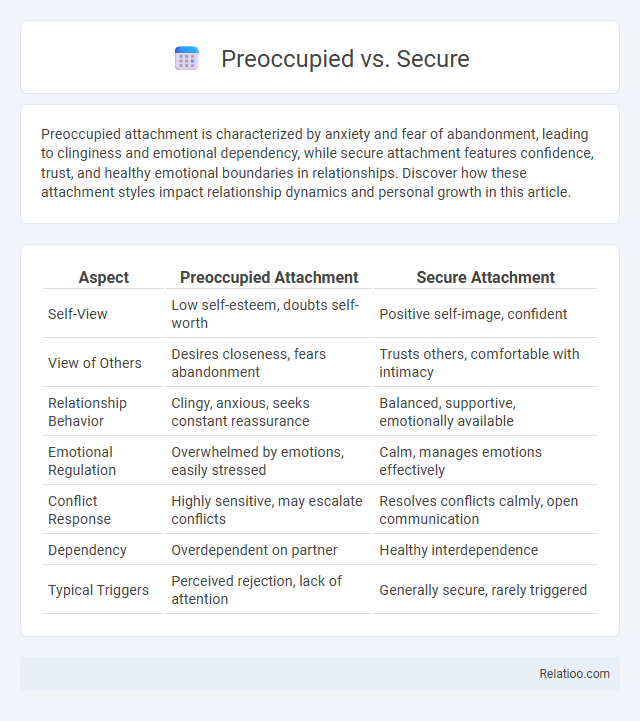Preoccupied attachment is characterized by anxiety and fear of abandonment, leading to clinginess and emotional dependency, while secure attachment features confidence, trust, and healthy emotional boundaries in relationships. Discover how these attachment styles impact relationship dynamics and personal growth in this article.
Table of Comparison
| Aspect | Preoccupied Attachment | Secure Attachment |
|---|---|---|
| Self-View | Low self-esteem, doubts self-worth | Positive self-image, confident |
| View of Others | Desires closeness, fears abandonment | Trusts others, comfortable with intimacy |
| Relationship Behavior | Clingy, anxious, seeks constant reassurance | Balanced, supportive, emotionally available |
| Emotional Regulation | Overwhelmed by emotions, easily stressed | Calm, manages emotions effectively |
| Conflict Response | Highly sensitive, may escalate conflicts | Resolves conflicts calmly, open communication |
| Dependency | Overdependent on partner | Healthy interdependence |
| Typical Triggers | Perceived rejection, lack of attention | Generally secure, rarely triggered |
Understanding Attachment Styles
Understanding attachment styles, particularly secure, preoccupied, and dismissive types, is crucial for healthy relationships. Secure attachment involves comfort with intimacy and autonomy, while preoccupied attachment is characterized by anxiety and a strong desire for closeness, often leading to dependency. Dismissive attachment features a preference for emotional distance and self-reliance, causing challenges in forming deep connections.
Defining Preoccupied Attachment
Preoccupied attachment is characterized by an intense need for approval and fear of abandonment, leading to clingy and anxious behaviors in relationships. Unlike secure attachment, where individuals maintain healthy boundaries and trust, preoccupied individuals often struggle with self-esteem and overdepend on others for validation. Understanding your attachment style can help you develop more secure and balanced emotional connections.
Characteristics of Secure Attachment
Secure attachment is characterized by comfort with intimacy and autonomy, allowing you to form trusting and balanced relationships. Individuals with secure attachment display effective emotional regulation, open communication, and resilience during conflicts. These traits foster long-lasting connections and a healthy sense of self-worth.
Emotional Patterns in Preoccupied Individuals
Emotional patterns in preoccupied individuals are often characterized by intense anxiety about relationships and a strong desire for closeness, driven by fears of abandonment. These individuals experience heightened emotional reactivity and sensitivity to perceived rejection, which can lead to clinginess or dependency in your interactions. Understanding these dynamics helps distinguish preoccupied attachment from secure attachment, where emotional regulation is balanced and trust is fundamental.
Behavior Traits of Securely Attached People
Securely attached people exhibit confident and trusting behavior, maintaining healthy boundaries and open communication in relationships. Your emotional regulation is balanced, allowing you to handle conflicts calmly and show empathy toward others. These behavioral traits foster stability and intimacy, distinguishing secure attachment from preoccupied or avoidant patterns.
Preoccupied vs Secure: Core Differences
Preoccupied attachment is characterized by anxiety and insecurity, causing individuals to seek constant reassurance and fear abandonment. Secure attachment reflects confidence and stability, enabling healthy communication and trust in relationships. Understanding these core differences helps you navigate emotional responses and build stronger bonds.
Impacts on Romantic Relationships
Preoccupied attachment in romantic relationships often leads to anxiety and fear of abandonment, causing partners to seek constant reassurance and exhibit clingy behaviors. Secure attachment promotes healthy communication, trust, and emotional intimacy, fostering stable and satisfying partnerships. In contrast, avoidant attachment results in emotional distance and reluctance to depend on others, which can create barriers to close connection and long-term relationship fulfillment.
Effects on Communication and Conflict
Individuals with a secure attachment style tend to communicate openly and effectively, fostering trust and mutual understanding in conflicts. Preoccupied attachment often leads to heightened emotional expression and anxiety, causing miscommunication and amplification of conflicts. Your ability to recognize these patterns can improve conflict resolution by tailoring communication strategies to each attachment style.
Steps to Move from Preoccupied to Secure Attachment
Transitioning from a preoccupied to a secure attachment style involves cultivating self-awareness through recognizing anxious patterns and understanding their origins. Building consistent, trusting relationships by setting healthy boundaries and communicating needs clearly strengthens emotional regulation and interpersonal confidence. Regularly practicing mindfulness and seeking therapy or support enhances resilience and fosters a stable, secure attachment foundation.
Seeking Help: Therapy and Self-Improvement
Individuals with a secure attachment style typically seek help through therapy and self-improvement with confidence and openness, recognizing their emotional needs and valuing personal growth. Those with a preoccupied attachment style often pursue therapy driven by anxiety and fear of abandonment, aiming to find reassurance and validation. In contrast, avoidant individuals may resist seeking help or engaging in self-improvement due to discomfort with vulnerability and reliance on others.

Infographic: Preoccupied vs Secure
 relatioo.com
relatioo.com